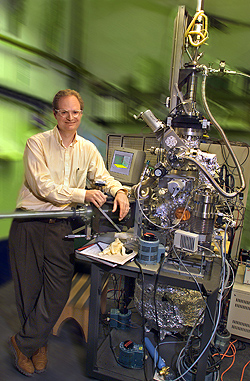Berkeleyan
Chemist Paul Alivisatos named Lawrence Award winner
![]()
| 28 February 2007
Professor of Chemistry Paul Alivisatos, director of the Materials Sciences Division at Lawrence Berkeley National Laboratory (LBNL), has been named one of eight winners of the Ernest Orlando Lawrence Award, it was announced recently by U.S. Secretary of Energy Samuel Bodman.
 Paul Alivisatos (Roy Kaltschmidt photo) |
Alivisatos shared the award in the materials-research category with Moungi Bawendi of the Massachusetts Institute of Technology "for chemical synthesis and characterization of functional semiconducting nanocrystals, also known as quantum dots."
The Lawrence Award honors scientists and engineers at mid-career for "exceptional contributions in research and development that support the Department of Energy (DOE) and its mission to advance the national, economic, and energy security of the United States." The award, given in seven categories, consists of a gold medal, a citation, and an honorarium of $50,000, which Alivisatos and Bawendi will share.
The winner in the life-sciences category, chemical engineer Arup Chakraborty of MIT, conducted much of his research on T cells during his 17-year stint at Berkeley and LBNL, prior to his move to MIT a year and a half ago.
"These brilliant scientists and their varied and important research inspire us," Bodman said. "Their work reminds us of the importance of continued investment in science and the need for increased emphasis on basic research and math- and science-education programs."
Alivisatos, also a professor of materials science in the College of Engineering and the Larry and Diane Bock Professor of Nanotechnology, is a nanomaterials chemist who pioneered the creation of nanometer-size crystals that exhibit unique properties not seen in larger crystals. Nanocrystals, sometimes called quantum dots, are now being used as tracers because, depending on size, they emit light of different colors. Alivisatos has extended these crystals into rods and other shapes that, in aggregate, have become the basis for a novel type of solar cell that is flexible and inexpensive.
Alivisatos also has helped launch several successful nanotech startup companies and mentored a growing body of highly successful young nanoresearchers.
Bawendi, a materials chemist, developed a synthesis of semiconductor nanocrystals that was the first to enable precise control of their size and precise determination of their properties. Using the Bawendi synthesis, nanocrystals are now routinely made to order.
According to a DOE press release, Chakraborty "has applied statistical mechanical methods to shed light on the molecular mechanisms that regulate the activation of T lymphocytes that orchestrate the immune response. His groundbreaking theoretical work has had widespread impact on experimental cellular and molecular immunology."
The Lawrence Award was established in 1959 to honor the memory of the late Ernest Orlando Lawrence, a Berkeley physicist and Nobel laureate who invented the cyclotron, or particle accelerator, and after whom two major DOE laboratories at Berkeley and in Livermore are named. This year's awards will be presented at a ceremony in Washington, D.C.

